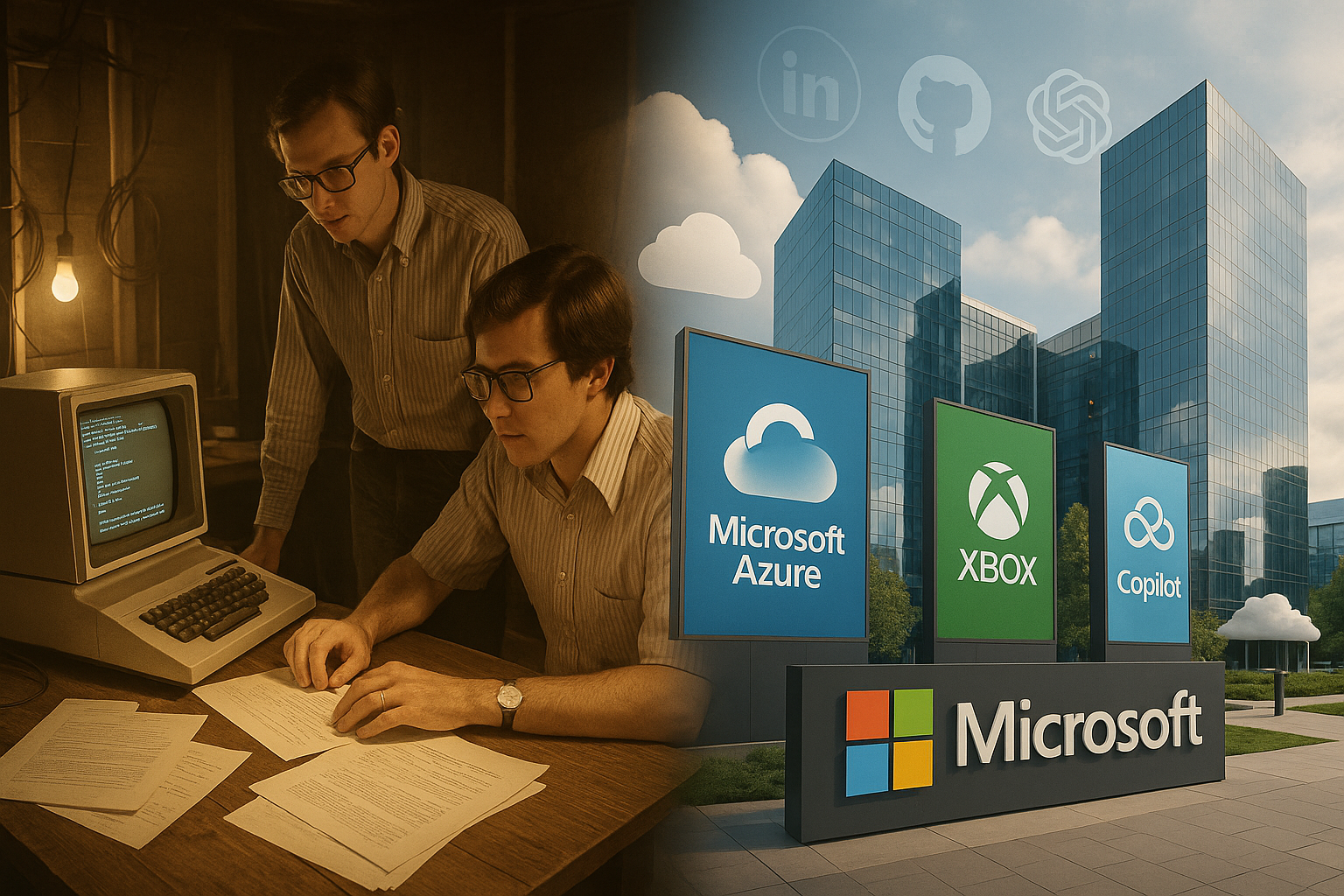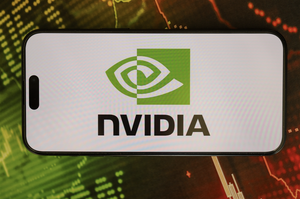
Microsoft Corporation (NASDAQ: MSFT), one of the world’s most influential technology companies, has shaped the modern digital era through innovation, strategic dominance, and adaptive evolution. From its humble beginnings in a garage to becoming a multi-trillion-dollar software and cloud computing juggernaut, Microsoft’s journey is a case study in vision, persistence, and reinvention.
The Humble Beginning: 1975–1980
The story of Microsoft began in 1975 when childhood friends Bill Gates and Paul Allen teamed up to develop software for the Altair 8800, one of the earliest personal computers. They founded Microsoft—originally stylized as “Micro-Soft”—to create an interpreter for the BASIC programming language. Though the company’s first office was a small garage in Albuquerque, New Mexico, its ambition was anything but modest.
By 1979, Microsoft had moved its headquarters to Bellevue, Washington, and was beginning to gain traction in the rapidly evolving microcomputer industry. In 1980, a pivotal moment arrived when IBM approached Microsoft to supply an operating system for its upcoming personal computer. Microsoft licensed an existing OS, modified it, and delivered MS-DOS—an operating system that would soon become the industry standard.
MS-DOS and Windows: 1981–1995
The launch of MS-DOS in 1981 catapulted Microsoft into the mainstream. As IBM PCs and compatibles flourished, so too did MS-DOS, cementing Microsoft’s role as the software supplier for a burgeoning PC industry.
The real game-changer, however, was Microsoft Windows. Released in 1985, Windows was initially a graphical shell on top of MS-DOS but quickly evolved into a standalone operating system. The Windows brand became synonymous with personal computing throughout the late 1980s and 1990s. Windows 3.0 (1990) and Windows 95 (1995) achieved widespread commercial success and helped secure Microsoft’s dominance.
The 1995 release of Windows 95 was especially significant. It introduced the Start menu, taskbar, and a user-friendly interface that became the standard for computing worldwide. The product’s unprecedented popularity helped make Microsoft one of the most valuable companies in the world by the mid-1990s.
The Office Empire and Internet Foray: 1990s
Alongside its operating systems, Microsoft launched Microsoft Office, a suite of productivity applications including Word, Excel, and PowerPoint. This package became essential in both home and corporate settings, reinforcing Microsoft’s software monopoly.
In response to the rise of the internet, Microsoft launched Internet Explorer in 1995. While it was initially slow to catch up with rivals like Netscape, Microsoft’s bundling strategy helped Internet Explorer eventually dominate web browsing—a tactic that would later land the company in legal trouble.
Antitrust and Growing Pains: Late 1990s–Early 2000s
Microsoft’s aggressive market tactics led to a landmark antitrust lawsuit by the U.S. Department of Justice in 1998. The court found Microsoft guilty of monopolistic behavior, particularly for bundling Internet Explorer with Windows. Though the company avoided being broken up, it was subjected to several restrictions and oversight that would shape its behavior for years.
During this time, Microsoft also entered new domains with mixed success. While the company saw wins with Windows Server and enterprise software, it struggled in areas like mobile computing and search engines. Attempts like the Zune music player and Windows Mobile failed to compete effectively with Apple (NASDAQ: AAPL) and Google (NASDAQ: GOOGL).
Reinvention and Cloud Revolution: 2010s
The turning point for Microsoft came with the appointment of Satya Nadella as CEO in 2014. Under his leadership, the company embraced open-source development, cross-platform compatibility, and most importantly—cloud computing.
Microsoft Azure, the company's cloud platform, quickly rose to become the second-largest cloud provider globally, trailing only Amazon Web Services (NASDAQ: AMZN). This pivot fueled a massive surge in revenue and earnings growth. Azure, along with Office 365 (now Microsoft 365), transformed Microsoft into a recurring-revenue machine.
During the same period, Microsoft made several strategic acquisitions, including the $26 billion purchase of LinkedIn in 2016, and later GitHub for $7.5 billion in 2018. These moves expanded Microsoft’s influence across professional networking and developer ecosystems.
Gaming and AI Expansion
Microsoft also doubled down on gaming through its Xbox platform and its acquisition strategy. The $68.7 billion acquisition of Activision Blizzard in 2023 positioned the company as a major player in the gaming industry, rivaling Sony and Nintendo. The move emphasized Microsoft’s long-term vision of controlling not just platforms, but content.
In artificial intelligence, Microsoft has become a dominant force, largely thanks to its strategic partnership and investment in OpenAI. By integrating AI capabilities like Copilot into its Office suite and Azure services, Microsoft is embedding generative AI into daily business operations. This transition represents a foundational shift in how the company delivers value to users.
Stock Growth and Financial Milestones
Microsoft's financial story mirrors its technological evolution. After going public in 1986, the company saw exponential stock appreciation through the 1990s tech boom. Despite the dot-com bust and various restructuring phases, Microsoft maintained resilience.
Under Satya Nadella, Microsoft stock (NASDAQ: MSFT) entered a new golden era. Its market capitalization surpassed $1 trillion in 2019 and $2 trillion in 2021. By mid-2025, Microsoft had become one of the top-valued companies globally, fueled by a diversified portfolio across cloud, software, enterprise, gaming, and AI.
The company’s strong balance sheet, high profit margins, and consistent dividend payouts have made it a favorite among institutional and retail investors alike. Microsoft’s stock is also a core holding in major ETFs and indices, including the S&P 500 and the Nasdaq-100.
The Road Ahead
As of 2025, Microsoft’s transformation is far from over. The company continues to innovate in quantum computing, cybersecurity, and digital collaboration. With AI and cloud computing at the core of global enterprise transformation, Microsoft is uniquely positioned to be a foundational pillar in the next generation of technology.
The company’s commitment to sustainability, ethical AI, and digital inclusion further demonstrates its ambition to lead not only in market share but in corporate responsibility.
Conclusion
From a tiny garage in Albuquerque to dominating global technology ecosystems, Microsoft Corporation has demonstrated remarkable adaptability. With a history that spans pioneering software, weathering regulatory storms, reinventing for the cloud era, and embracing AI-driven futures, Microsoft’s story is one of relentless evolution.
Its stock performance reflects investor confidence in its diversified business model and future-facing strategies. As it approaches its 50th anniversary in 2025, Microsoft remains one of the most influential forces in shaping the digital age.
Disclaimer: This article is for informational purposes only and does not constitute financial advice or a recommendation to buy or sell any securities. Investors should conduct their own research or consult a qualified financial advisor before making investment decisions.





